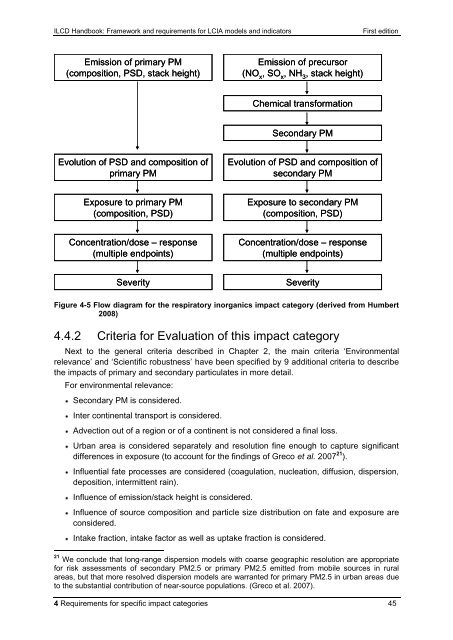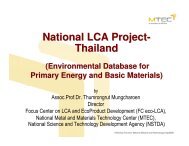ILCD Handbook: Framework and requirements for LCIA models and ...
ILCD Handbook: Framework and requirements for LCIA models and ...
ILCD Handbook: Framework and requirements for LCIA models and ...
You also want an ePaper? Increase the reach of your titles
YUMPU automatically turns print PDFs into web optimized ePapers that Google loves.
<strong>ILCD</strong> <strong>H<strong>and</strong>book</strong>: <strong>Framework</strong> <strong>and</strong> <strong>requirements</strong> <strong>for</strong> <strong>LCIA</strong> <strong>models</strong> <strong>and</strong> indicators First edition<br />
Emission of primary PM<br />
(composition, PSD, stack height)<br />
Evolution of PSD <strong>and</strong> composition of<br />
primary PM<br />
Exposure to primary PM<br />
(composition, PSD)<br />
Concentration/dose – response<br />
(multiple endpoints)<br />
Severity<br />
Emission of precursor<br />
(NO x , SO x , NH 3 , stack height)<br />
Chemical trans<strong>for</strong>mation<br />
Secondary PM<br />
Evolution of PSD <strong>and</strong> composition of<br />
secondary PM<br />
Exposure to secondary PM<br />
(composition, PSD)<br />
Concentration/dose – response<br />
(multiple endpoints)<br />
Severity<br />
Figure 4-5 Flow diagram <strong>for</strong> the respiratory inorganics impact category (derived from Humbert<br />
2008)<br />
4.4.2 Criteria <strong>for</strong> Evaluation of this impact category<br />
Next to the general criteria described in Chapter 2, the main criteria ‗Environmental<br />
relevance‘ <strong>and</strong> ‗Scientific robustness‘ have been specified by 9 additional criteria to describe<br />
the impacts of primary <strong>and</strong> secondary particulates in more detail.<br />
For environmental relevance:<br />
Secondary PM is considered.<br />
Inter continental transport is considered.<br />
Advection out of a region or of a continent is not considered a final loss.<br />
Urban area is considered separately <strong>and</strong> resolution fine enough to capture significant<br />
differences in exposure (to account <strong>for</strong> the findings of Greco et al. 2007 21 ).<br />
Influential fate processes are considered (coagulation, nucleation, diffusion, dispersion,<br />
deposition, intermittent rain).<br />
Influence of emission/stack height is considered.<br />
Influence of source composition <strong>and</strong> particle size distribution on fate <strong>and</strong> exposure are<br />
considered.<br />
Intake fraction, intake factor as well as uptake fraction is considered.<br />
21 We conclude that long-range dispersion <strong>models</strong> with coarse geographic resolution are appropriate<br />
<strong>for</strong> risk assessments of secondary PM2.5 or primary PM2.5 emitted from mobile sources in rural<br />
areas, but that more resolved dispersion <strong>models</strong> are warranted <strong>for</strong> primary PM2.5 in urban areas due<br />
to the substantial contribution of near-source populations. (Greco et al. 2007).<br />
4 Requirements <strong>for</strong> specific impact categories 45



